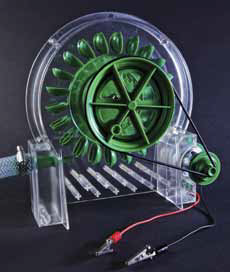PowerWheel
By Ken Roberts
Posted on 2012-07-01
Recently, I had the opportunity to test out the Power- Wheel by R.B. Manufacturing. The PowerWheel is a micro hydro generator that can be hooked up to a faucet or hose. It is designed to model how electricity can be generated and to show the transfer of energy. I was intrigued to test this product as the transfer of energy is a difficult concept for middle school students to grasp. Overall, the PowerWheel is a sturdy piece of equipment that comes partially assembled. Eighth-grade students were able to fully assemble the apparatus as shown using the directions provided. If you have a garden-hose spigot at your school, you will have no troubles powering the generator by running the water through the hose. You can also use a pencil to turn the wheel by hand. Enough electricity is produced to get a string of LED lightbulbs to illuminate. The PowerWheel comes with an extremely useful Learning Guide, which is also available as a pdf on the manufacturer’s website. This is a handy option if you want each student to read to learn more about energy. The majority of the publication is informational text covering forms of energy, transfer of energy, and how electricity is created. The content provided is accurate and has graphical representations to allow for ease of comprehension. We were able to use some of the charts, including one on Energy in Our Lives, to assess students on reading charts and graphs as well as learning energy concepts. After you have your PowerWheel hooked up to a water source, it is very easy to demonstrate how energy is transferred by turning on the water and watching the lights begin to glow. However, this demonstration would take less than ten seconds, and wouldn’t require students to engage in any higher-level thinking. The utility of the PowerWheel comes with actually using the device to conduct investigations. Students are able to make qualitative and quantitative measurements as the PowerWheel generates electricity. To assist teachers, the last two pages of the Learning Guide have lesson ideas. In addition, the website provides lesson plans for teachers. If you are new to teaching energy, the lessons will be easy to understand and duplicate. Experienced teachers will be able to easily modify the lesson ideas to meet the needs of their classrooms. The website is not static. New lessons continue to be developed and added. I was able to have students create experimental design investigations to learn more about forms of energy, electricity, and energy transfers. These experiments are what make the PowerWheel valuable to your classroom. You can measure the electrical current using an ammeter at different flow rates. You can see the difference between lighting LED bulbs versus a bike lamp (incandescent bulb). When I looked at postassessment data, I found that students increased their understanding of forms of energy and transfer of energy as a result of using the PowerWheel. I did have one difficulty using the PowerWheel—getting it to connect to a faucet. I did not have a hose to connect the PowerWheel and needed to use a faucet in a classroom. The hose did not automatically connect. In one room, I first had to buy an adapter for the faucet. Then I discovered that my faucet was still too small and had to return to buy another adapter for my adapter. The total extra cost was about $10, but a suggestion would be to make sure you are able to hook everything up ahead of time. Once I had the hose adaptors in place, the PowerWheel worked well in this room. However, in the lab downstairs, the water pressure was not great enough to turn the wheel. Overall, I would recommend the PowerWheel if you want students to investigate electricity and how energy changes forms. It is a simple model that is engaging and has real-world applications.
Disclaimer: The views expressed in this blog post are those of the author(s) and do not necessarily reflect the official position of the National Science Teaching Association (NSTA).



